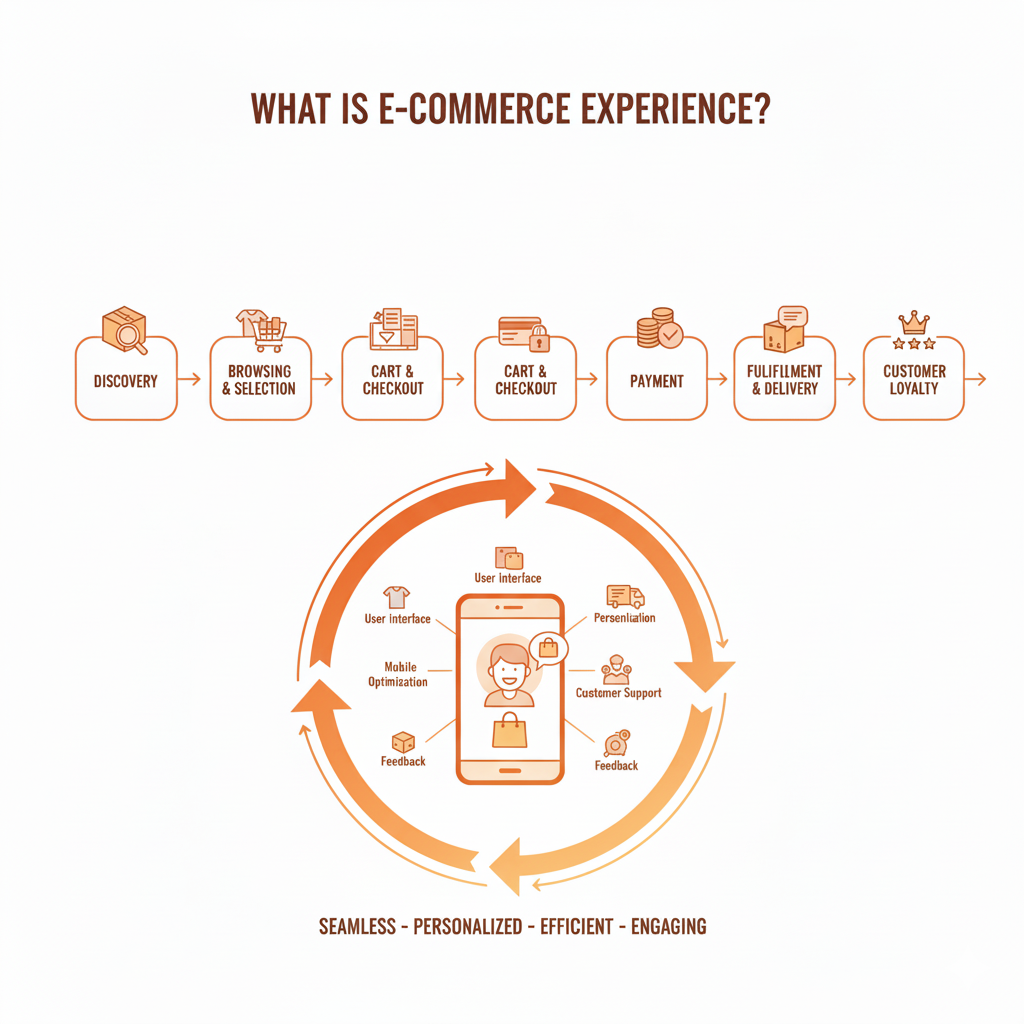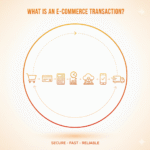When you visit an online store and everything just flows the pages load fast, the products look great, checkout feels effortless that’s what we call a great e-commerce experience.
But when the site is slow, navigation is messy, or checkout fails midway, you’re left annoyed. That’s a bad one.
Now, if you’re running (or planning to start) an online store, understanding e-commerce experience isn’t just good to know it’s a must. Because currently, customers don’t just buy products anymore; they buy experiences.
So, let’s go deep into what e-commerce experience actually means, why it’s crucial for your business, how to measure it, and most importantly how to make it better.
What Exactly Is E-Commerce Experience?
At its core, e-commerce experience refers to everything a customer feels and does when interacting with your online store from discovering it to receiving their order.
It includes your website or app’s design, speed, usability, checkout process, customer service, and even how your brand communicates before and after a purchase.
In simple terms:
E-commerce experience = how easy, enjoyable, and trustworthy your store feels to your customers.
It’s the digital version of walking into a physical store. Imagine this:
You walk into a shop. It’s clean, well-lit, products are easy to find, the staff is friendly, and billing takes seconds that’s a great experience.
But if the shop is messy, pricing is unclear, or checkout is confusing, you’ll leave quickly.
Online shopping works the same way just without the physical space. Your e-commerce website or mobile app is your digital store. Every click, scroll, and form fill matters.
Why E-Commerce Experience Matters More Than Ever
With thousands of online stores selling the same thing, your experience is what sets you apart.
Here’s why it’s so critical:
1. Customer Expectations Are Higher
Shoppers expect speed, personalization, and simplicity. If you don’t deliver, they’ll move on because they can. There’s always another store one click away.
2. First Impressions Are Everything
It takes about 50 milliseconds for visitors to decide whether they’ll stay or leave your website.
A clean layout, quick loading speed, and easy navigation can make that split-second difference.
3. Experience Drives Conversions
You could have great products and pricing, but if checkout is complicated or your site feels clunky, customers will abandon their carts.
A good experience directly improves your conversion rate.
4. Builds Long-Term Loyalty
When shopping feels smooth and reliable, people come back. And repeat customers are far more valuable than new ones they spend more and trust your brand.
5. Reduces Customer Support Load
If your site is easy to use, fewer customers will get stuck or confused. That means fewer support tickets and happier staff.
In short, the better your e-commerce experience, the more money you’ll make and the less you’ll spend fixing issues.
The 7 Core Elements That Define an E-Commerce Experience
A good e-commerce experience doesn’t happen by accident. It’s built on several key components that work together to create a seamless customer journey.
Let’s break each one down.
1. Website Performance and Visual Design
The foundation of any good e-commerce experience is speed and design.
If your site takes forever to load, most users won’t wait. According to Google, over 53% of mobile users leave a site that takes more than 3 seconds to load.
What to focus on:
- Fast load time: Compress images, use a CDN, and optimize your hosting.
- Responsive design: Your website should look and work perfectly on all screen sizes.
- Clean interface: Avoid visual clutter. Highlight key actions like “Add to Cart” or “Buy Now.”
- Consistent branding: Colors, fonts, and tone should reflect your brand personality.
A visually appealing, fast-loading store immediately builds trust and reduces bounce rates.
2. User Navigation and Site Structure
Navigation is like the layout of a physical store. If people can’t find what they want, they’ll leave.
Tips for better navigation:
- Use clear menu categories (e.g., “Men,” “Women,” “Sale,” instead of vague names).
- Add filters and sorting options for large catalogs.
- Keep breadcrumbs so users can easily backtrack.
- Add a search bar that gives smart suggestions.
Every click should feel intuitive. Shoppers shouldn’t have to “think” about what to do next — that’s your job as the store owner.
3. Product Experience: Photos, Details, and Trust
When customers can’t touch or try a product, they rely on your visuals and descriptions.
What matters most:
- High-quality images: Show multiple angles and real-life usage if possible.
- Videos or 360° views: They increase engagement and trust.
- Detailed descriptions: Go beyond specs — focus on benefits.
- Customer reviews and ratings: Real feedback helps overcome hesitation.
- Stock and delivery info: Be transparent about availability and shipping times.
A strong product presentation answers all possible customer questions before they even ask them.
4. Checkout Process: The Make-or-Break Moment
This is where many stores lose sales. A great checkout should be fast, simple, and secure.
To improve checkout:
- Allow guest checkout (don’t force account creation).
- Show progress indicators (like “Step 2 of 3”).
- Offer multiple payment methods (cards, UPI, wallets, PayPal).
- Display clear pricing and shipping info upfront.
- Add trust badges and secure payment icons.
Every unnecessary field or step increases the chance of abandonment. Your goal: make checkout frictionless.
5. Personalization and Recommendations
In modern e-commerce, personalization is no longer optional — it’s expected.
Customers love when stores “get” them.
Ways to personalize the experience:
- Show “Recommended for You” products.
- Send personalized emails (cart reminders, birthday discounts, etc.).
- Use browsing or purchase history to display relevant products.
- Adjust homepage banners based on user behavior.
Amazon built its empire on personalization. Small stores can achieve similar results with smart plugins and analytics tools.
6. Customer Support and Post-Purchase Experience
Your relationship with customers doesn’t end when they buy something. In fact, it’s just starting.
A smooth post-purchase experience keeps them coming back.
What to offer:
- Order tracking: Keep customers updated at every stage.
- Easy returns: Simplify the process with clear policies.
- 24/7 chat or email support: Solve issues fast.
- Follow-up messages: Thank customers, ask for feedback, or suggest complementary products.
People remember how you treat them after they pay. A great support experience often turns one-time buyers into loyal fans.
7. Mobile and Omnichannel Experience
Most e-commerce traffic now comes from mobile devices. If your site doesn’t perform well on phones, you’re losing customers.
Make sure to:
- Use a responsive layout (no pinching or zooming needed).
- Optimize buttons and forms for touch screens.
- Simplify navigation for smaller screens.
- Ensure your emails and popups are mobile-friendly.
Beyond that, your brand should deliver a consistent omnichannel experience — whether someone interacts via your website, app, social media, or even WhatsApp.
If they add something to their cart on mobile, it should still be there on desktop. That’s seamless experience.
Measuring Your E-Commerce Experience: What to Track
You can’t improve what you don’t measure. Here are key metrics that reveal how strong your e-commerce experience really is:
- Conversion Rate: Percentage of visitors who make a purchase.
- Cart Abandonment Rate: High numbers often point to checkout issues.
- Bounce Rate: If people leave quickly, your site or content isn’t engaging enough.
- Average Session Duration: Longer sessions usually mean better engagement.
- Customer Satisfaction (CSAT): Ask users how they’d rate their shopping experience.
- Net Promoter Score (NPS): Measures how likely they are to recommend your store.
- Repeat Purchase Rate: A clear indicator of loyalty and post-purchase satisfaction.
You can gather insights using tools like Google Analytics, Hotjar, or Shopify’s built-in analytics dashboard.
Real-World Example: How Amazon Nails the E-Commerce Experience
Amazon is often seen as unbeatable — and for good reason. Its success doesn’t just come from low prices or fast delivery, but from a world-class user experience.
Here’s what Amazon gets right:
- Speed: Pages load almost instantly.
- Simplicity: Product pages are easy to scan.
- Personalization: Recommendations are hyper-relevant.
- Trust: Clear reviews, secure checkout, and reliable delivery.
- Customer-first policies: Hassle-free returns, refunds, and responsive support.
Amazon makes the entire journey — from search to delivery — feel effortless. That’s what every e-commerce brand should aim for, regardless of size.
How to Improve Your E-Commerce Experience (Step-by-Step)
Even if your store is small, you can build an impressive customer experience with consistent improvements. Here’s a roadmap:
Step 1: Audit Your Website
Browse your site as if you’re a new visitor. Find friction points — slow pages, unclear buttons, or confusing layouts.
Step 2: Optimize Site Speed
Use tools like Google PageSpeed Insights or GTmetrix. Compress images, remove unnecessary plugins, and use caching.
Step 3: Revamp Product Pages
Rewrite product descriptions to highlight benefits and add fresh, optimized visuals.
Step 4: Simplify Checkout
Fewer steps = more conversions. Offer guest checkout, autofill options, and real-time validation for forms.
Step 5: Add Social Proof
Show customer reviews, testimonials, or real-user photos. It builds instant trust.
Step 6: Offer Personalized Experiences
Use customer data (ethically) to recommend products and tailor offers. Many platforms like Shopify or WooCommerce have plugins for this.
Step 7: Focus on Mobile Optimization
Test your site across devices. Fix broken layouts, oversized images, and overlapping elements.
Step 8: Improve Post-Purchase Engagement
Follow up with thank-you emails, feedback requests, or future discounts.
Step 9: Collect Continuous Feedback
Surveys, polls, and reviews tell you exactly what customers love or dislike. Use that insight to improve.
Step 10: Test and Iterate
A great e-commerce experience is never “done.” Keep testing and refining. Even small changes — like moving a button or rewording a headline — can boost conversions.
Common Mistakes That Ruin E-Commerce Experience
Avoiding these pitfalls can save you time and customers:
- Slow websites: The number one conversion killer.
- Hidden costs: Surprise fees at checkout lead to cart abandonment.
- Complicated navigation: Too many categories confuse users.
- Forced sign-ups: Don’t make registration mandatory.
- Weak product details: Shoppers need clarity before they buy.
- Lack of trust signals: Missing SSL, reviews, or contact info turns users away.
Remember, even one friction point can undo all your marketing efforts.
The Future of E-Commerce Experience
E-commerce is evolving rapidly. Here’s what’s shaping its future:
- AI-driven personalization: Smarter product recommendations and predictive shopping.
- Voice commerce: Shopping through Alexa or Google Assistant.
- AR/VR experiences: Try-before-you-buy experiences online.
- Hyper-fast delivery: Same-day or even 2-hour delivery becoming standard.
- Sustainability focus: Shoppers prefer eco-friendly packaging and ethical brands.
In this fast-changing landscape, staying customer-focused is your best strategy. Technology will change, but the goal remains the same: make shopping as easy and delightful as possible.
Key Takeaways
- E-commerce experience is the complete journey customers go through from discovery to post-purchase.
- It’s built on speed, design, usability, personalization, and trust.
- A strong experience boosts conversions, loyalty, and brand reputation.
- Measure key metrics like conversion rate, NPS, and bounce rate to track improvements.
- Keep optimizing e-commerce is a continuous process, not a one-time fix.
In the end, success isn’t just about selling more. It’s about creating experiences people remember and return for.
Conclusion
A great e-commerce experience is like a conversation smooth, natural, and built on trust.
If you can make your customers feel confident, valued, and comfortable while shopping, you’ll not only win more sales but also create loyal advocates who promote your brand for free.
Start small. Fix one friction point at a time. Over weeks and months, these small improvements add up to something powerful a shopping experience that truly stands out in the noisy world of online retail.



Pingback: What Is an E-Commerce Transaction? The Complete Guide You Need to Understand Online Buying - Pratsify
Pingback: What Is E-Commerce Packaging? (Complete Beginner-Friendly Breakdown) - Pratsify